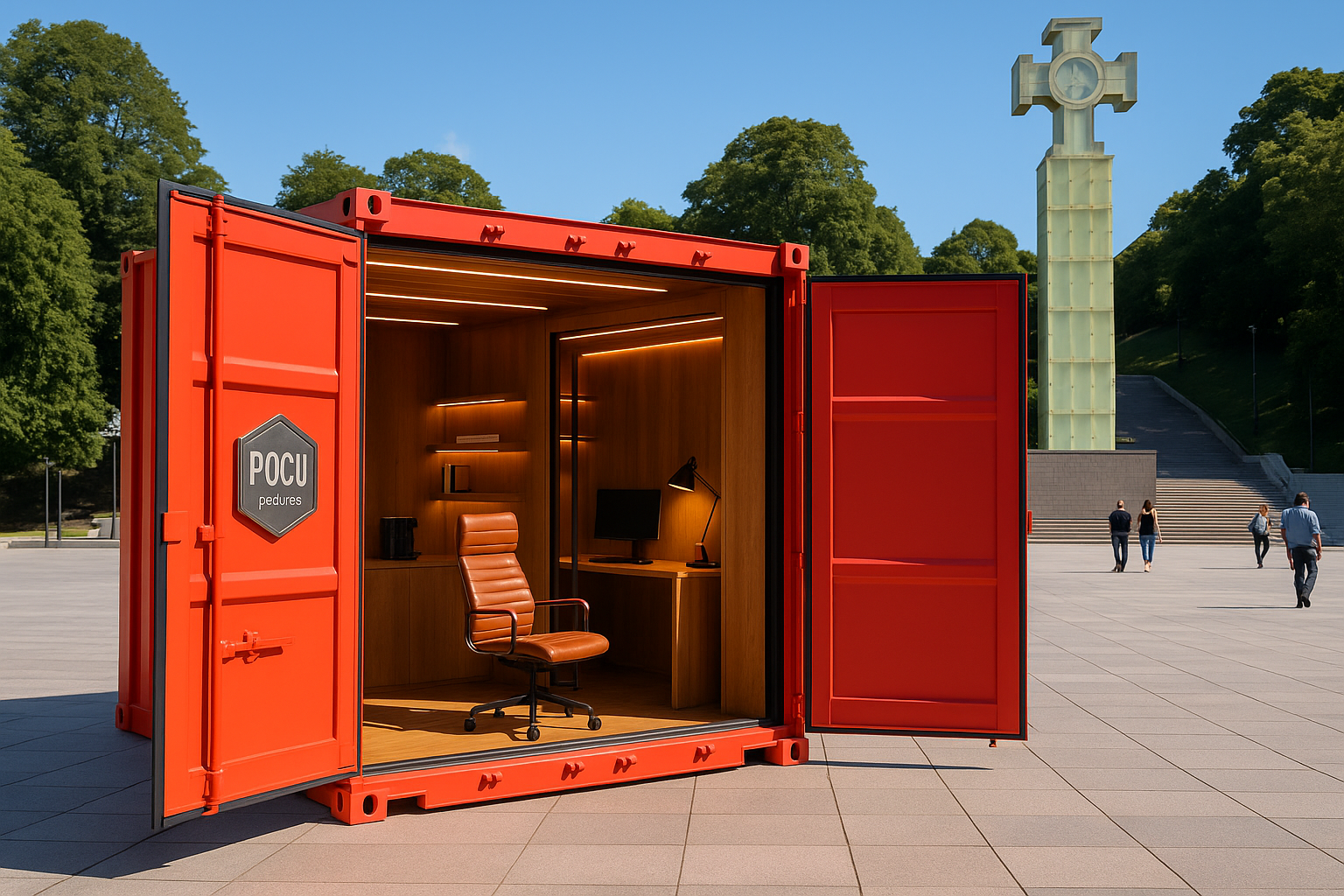In today's dynamic work environment, offices made from repurposed shipping containers are gaining popularity as a flexible and eco-conscious option. These structures provide a cost-effective, adaptable alternative to traditional buildings.
Overview
-
Container offices generally measure 6 to 12 meters in length and can be configured in numerous ways to suit different needs.
-
Building with containers is often more economical than conventional construction methods.
-
Reusing steel containers reduces waste and environmental impact.
-
The robust steel build offers durability against harsh weather.
-
Minimal groundwork is needed, allowing for fast setup.
Basics of Container-Based Offices
These offices are created from standard steel containers, commonly 6 or 12 meters long. Known for their strength and resistance to the elements, they work well as mobile or permanent office units.
Sizes and Space Planning
The 6-meter units are ideal for compact setups, while 12-meter options offer more room for multifunctional use. Width and height are typically around 2.4 meters and 2.6 meters, respectively, making them suitable for stacking or side-by-side configurations.
Materials and Setup
While the outer shell is made of corrosion-resistant steel, the interior often needs insulation, wall panels, electrical wiring, lighting, and climate control systems to function effectively as a workplace.
Compact Layouts Using 6-Meter Containers
These smaller containers are highly versatile. They can be arranged as open spaces or divided into separate zones for privacy. Modular furniture, built-in shelves, and smart storage systems help make efficient use of limited floor area.
Modern tech features like integrated power outlets, wireless connectivity, and energy-efficient lighting enhance the usability and comfort of the space.
Why Choose Container Offices?
-
Cost: Building with containers typically costs far less per square meter than conventional offices.
-
Speed: Quick assembly helps reduce project timelines.
-
Sustainability: Reusing containers supports eco-friendly building practices.
-
Mobility: They can be moved or expanded as business needs change.
Legal and Regulatory Aspects
Setting up a container office requires adherence to local zoning laws and building regulations. Some areas may need special permits depending on the office size or intended use. It’s important to consult with local authorities early in the process.
Design Flexibility
Container offices can be customized in countless ways—from single workstations to larger complexes. Important considerations include traffic flow, lighting, acoustics, and comfort. Good planning supports productivity and company culture.
Costs can range significantly depending on condition and level of customization. Pre-fabricated units may start around €4,500, while highly customized designs can reach upwards of €18,000. Adding features like plumbing or interior design elements may increase this range.
Maximizing Larger Layouts with 12-Meter Containers
These units provide enough space for dedicated areas like meeting rooms, private offices, or collaborative zones. Good ventilation and natural light should be a priority. Movable partitions allow reconfiguration over time.
To avoid clutter, consider vertical storage and modular features. The goal is to balance utility, comfort, and aesthetics.
Smart Design Considerations
-
Space Optimization: Use furniture that serves multiple purposes and plan for vertical storage.
-
Lighting & Air: Ensure natural light and good airflow. Incorporate insulation and ventilation systems.
-
Interior Styles: From open plans to segmented zones, layouts should align with how the business functions.
Cost Planning
While initial investments vary, container offices typically cost less long-term thanks to lower energy and maintenance needs. Modular designs allow businesses to scale up without major renovations.
Average per-square-meter costs range between €1,400 to €3,200, depending on the region and features. In South Asia, for example, a new 6-meter container may cost around ₹1,80,000–₹2,00,000, with local delivery charges of ₹35,000 to ₹75,000.
Modifications and Installations
-
Windows & Doors: Placement affects light and air; proper sealing maintains structure and insulation.
-
Insulation Options: Spray foam offers the best seal, while panel and blanket insulation are easier to install but take up more space.
-
Utilities: Plan for electric, water, and HVAC early in the design stage to avoid costly changes later.
Interior Ideas
Designing for functionality and comfort includes selecting calming color schemes, ergonomic furniture, and acoustic treatments. Even a 6-meter unit can include desks, storage, and small washrooms or meeting spaces.
A modular conference room or sales office is also possible with minor customizations.
Future Outlook
Upcoming trends show a shift toward adaptable layouts, sustainable materials, and tech-integrated features. Modular expansion, solar energy, and environmentally friendly designs are becoming standard. Aesthetic customization will also play a bigger role, with businesses using design to reflect brand identity.
Green Features
-
Energy Efficiency: Use natural lighting, solar panels, and LED fixtures.
-
Eco Materials: Opt for recycled wood, low-emission paints, and sustainable finishes.
-
Living Roofs: Green roofs or plant walls can improve insulation and air quality.
Multi-Unit Configurations
Multiple containers can be joined horizontally or vertically to form large, multifunctional office spaces. Layouts may include courtyards, private and shared zones, or full corporate suites. Structural safety is essential, especially when stacking units.
Preparing the Site
Good site prep includes leveling the ground, clearing vegetation, and installing drainage. Common foundation choices include pier footings and compacted gravel beds, which support the container without the need for a full concrete slab.
Installation Steps
-
Measure and mark the site.
-
Position the container securely.
-
Join units if necessary.
-
Connect utilities.
Professional guidance ensures compliance and a smooth setup.
Maintenance Tips
Regular inspections for rust, leaks, and wear can extend the life of a container office. Maintain paint, check seals, and service HVAC systems. Interior upkeep prevents mold and ensures a healthy workspace.
Routine care includes:
-
Checking hinges and locks
-
Clearing drainage
-
Cleaning surfaces
-
Inspecting plumbing and electrical connections
Choosing the Right Layout
Your layout should reflect how your business operates. Open spaces encourage collaboration, while divided rooms offer privacy. Design also impacts client perception, so think about how the space looks and feels.
Consider future expansion, comfort, and workflow when deciding how to organize your container office.
Conclusion
Container-based offices offer a practical, efficient, and environmentally sound solution for many businesses. They provide flexibility in design, lower costs, and quick installation. With thoughtful planning and ongoing maintenance, they can serve as modern, comfortable work environments for years to come.

Container Office Rental Services
Welcome to our Container Office Rent Services, where we provide a wide range of flexible and affordable rental solutions to meet the diverse needs of businesses and construction sites. Whether you require a small office space, temporary accommodation, or on-site storage, we have the perfect portable solution for you.
2x3 Container Office Rental and Portable Cabin for Rent
Are you in search of a compact yet efficient workspace for your project, temporary office, or remote location? Our 2x3 Container Office Rental is the perfect solution. Crafted with durability and functionality in mind, this container office offers a professional environment with all the essential features packed into a space-saving design.
Perfect for small teams or individual use, this 10x8 container office is well-suited for construction sites, pop-up offices, or remote workstations. Its portable structure and practical layout ensure smooth operations, providing your team with a comfortable and productive space wherever it’s needed.
